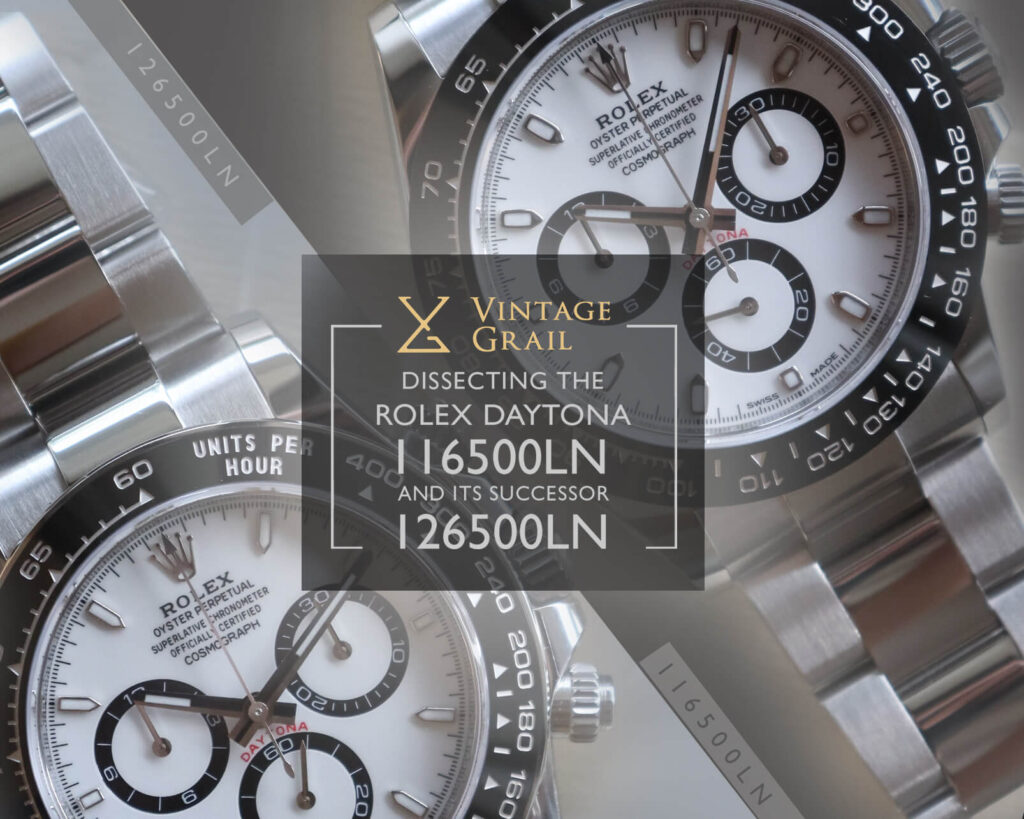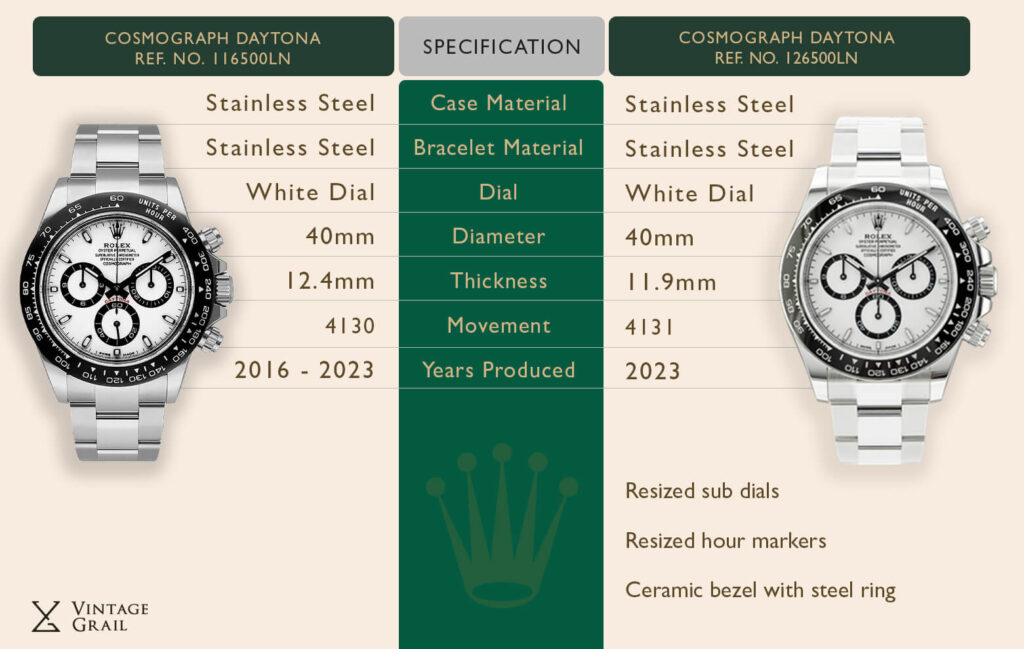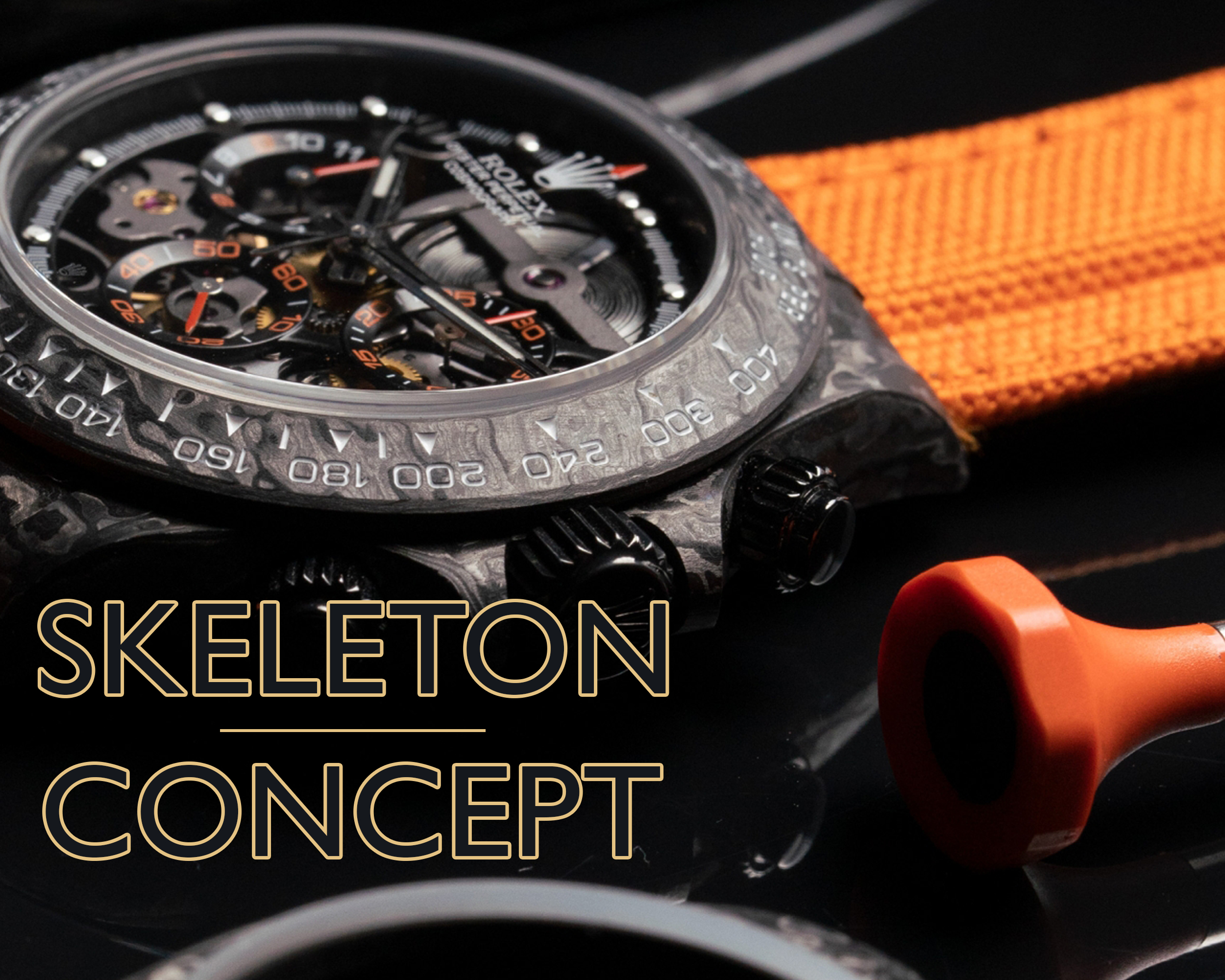Dissecting the Rolex Daytona 116500LN and its successor, the 126500LN
By: Xavi Panlilio | Posted: January 04, 2024
Intro
When Rolex introduced the Cosmograph Daytona in 1963, it began a captivating journey into the hearts of collectors and enthusiasts, earning its place with a rich heritage that echoes through time. Over the years, Rolex has meticulously crafted various iterations of the esteemed Daytona model, contributing to its legendary status. The watch’s evolution into an icon is not solely attributed to its precision and craftsmanship. Still, it is equally shaped by the profound connections and historical significance it has accrued over time.
The name “Daytona” pays homage to its inseparable connection with the illustrious racetrack, infusing the watch with layers of history, significance, and sporting prestige. A fusion of functionality and style, the Cosmograph Daytona transcends the confines of mere timekeeping, embodying a timeless allure that captivates watch enthusiasts and connoisseurs alike. As the watch continues to command admiration, it stands tall as an enduring symbol of craftsmanship, legacy, and Rolex’s unwavering commitment to excellence in high-end timepieces.
But on its 60th anniversary, Rolex bids farewell to the 116500LN, a model from 2016 to 2023. The brand opted to refresh the entire Daytona collection to celebrate this milestone. While the new 126500LN may appear almost identical to its predecessor, subtle changes exemplify Rolex’s approach to refining its core models. Although Rolex is convinced that these modifications enhance the Daytona, opinions among collectors vary regarding the new look of this iconic timepiece. Before reaching a verdict, let’s delve into a comparison between the previous Rolex Cosmograph Daytona ref. 116500LN and the new ref. 126500LN, allowing you to decide which one you prefer.
Case
Let’s dive into the fundamentals, starting with the case of the new Daytona 126500LN. Initially, it may appear that little has changed – the watch maintains a 40mm diameter. However, upon closer inspection of the intricate details, one will observe a discreet yet comprehensive redesign of the entire case. Regarding dimensions, it’s noteworthy that the thickness now measures 11.9mm, a reduction of approximately 0.5mm compared to the previous generation.
The lugs have undergone reshaping, achieving symmetry between the left and right sides. In contrast to the earlier generation Daytona, characterized by an asymmetrical case with slimmer proper lugs, the redesign offers a more balanced aesthetic. Furthermore, the crown guard has transformed, now elongated and gracefully curved from top to bottom, seamlessly integrating into the overall design. The rear maintains its classic fluted, screwed element in solid steel, except for the platinum model in the 126500LN lineup, which features a transparent sapphire case back. These refinements may be subtle, but their distinctive features become unmistakably apparent upon recognition.
The metallic ring framing the bezel is a notable enhancement in the new Daytona. Previously, the Daytona featured a complete ceramic ring, but the updated design incorporates a slender, polished band crafted from the same material as the case. Adding a metallic ring enhances durability, providing increased resistance against potential damage compared to ceramic, which is prone to shattering.
Dial
The changes on the dial are seen on the hands, markers, and the sub-dials. Both have been reduced in size to bring a more modern, sleeker look without compromising legibility and contrast. The hour markers are now smaller and far better defined than in the past and feature a thinner metallic ring, offering more space for the luminous Chromalight insert inside. The hands, still combining a black lacquered band and a luminous insert, are slightly thinner to remain consistent with the rest of the dial.
Another modification involves the resized contrasting rings encircling the sub-dials. While the external diameter remains unchanged, the internal diameter has been expanded, resulting in a narrower black textured element. This, coupled with the reduced size of the applied markers, introduces a more breathable quality to the dial, enhancing the overall harmony of the new graphics.
Taking note of minor details, there’s the presence of a small Coronet at 6 o’clock, denoting a new-generation movement, along with slightly slimmer fonts throughout. However, aspects such as the extensive text at 12 o’clock (comprising five lines — a suggestion to Rolex to relocate the “Superlative Chronometer Officially Certified” notation to the caseback), the position of the counters (still marginally higher than the central axle), and the red “Daytona” inscription above the small seconds counter remain unchanged.
Movement
While the movement is prominently displayed on the case back of the platinum edition, the mechanical refinement in the steel Daytona 126500LN (and gold models) is discreetly concealed. The latest iteration of the Cosmograph now houses the caliber 4131. This new movement represents the first publicly acknowledged update to the caliber 4130—a self-winding chronograph movement designed and continuously produced by Rolex since 2000. It’s worth noting that although the 4130 has seen some subtle, undisclosed updates over the years, the caliber 4131 remains concealed by a solid caseback on all Rolex Daytona models, except the platinum variant.

Overall
With the unveiling of the steel Rolex Daytona 116500LN in 2016, even Rolex likely didn’t anticipate the challenge it would pose to enhance such a meticulously crafted design. Fast forward seven years to the 60th anniversary of the collection, signaling the opportune moment for innovation. Rolex anticipated confronting this task head-on, aiming to modify one of its pinnacle designs, the 116500LN steel Daytona.
However, despite these expectations, many of the Daytona alterations seem challenging to rationalize, appearing more regressive than progressive. The asymmetry in design, the nuanced contours of the lugs, case profile, and hour markers, the monoblock, and unframed ceramic bezel, and the impeccable overall proportions of the steel Daytona—none of these elements are haphazard in watch design, especially at this caliber. Yet, these deliberately calculated refinements have been undone without any discernible historical or practical justification. So let us know which one you prefer! Both have pros and cons, but by the looks of it, the 126500LN is here to stay for quite a while, so we either love it or learn to love it.
If any of the watches mentioned in this article interest you, we are here to help! Our experts are here to assist you. Email us at [email protected] or (+63) 917 159 1211, and our specialists will gladly assist you. You may also visit our website www.vintagegrail.com.
Disclaimer: The views and opinions contained in this article belong solely to the individual author and do not reflect the views and opinions of the company. We are not affiliated, associated, authorized, endorsed by, or in any way officially connected with any of the brands mentioned, or any of its subsidiaries or its affiliates.






